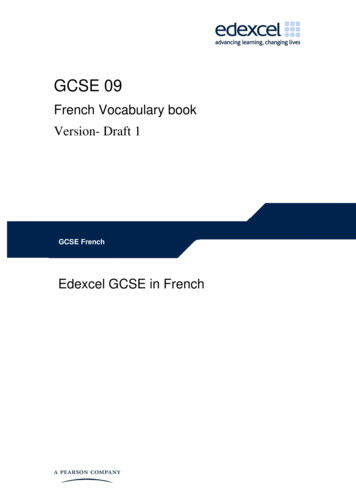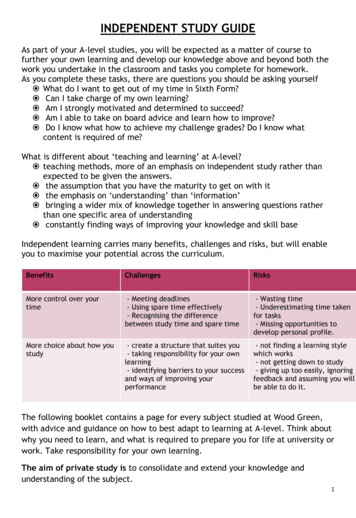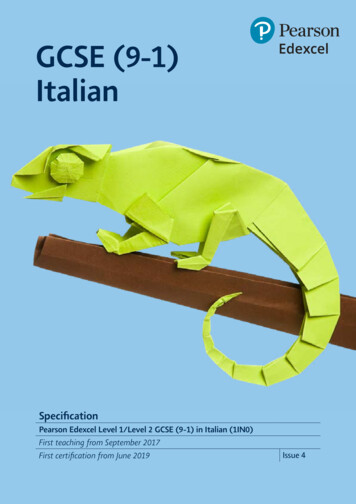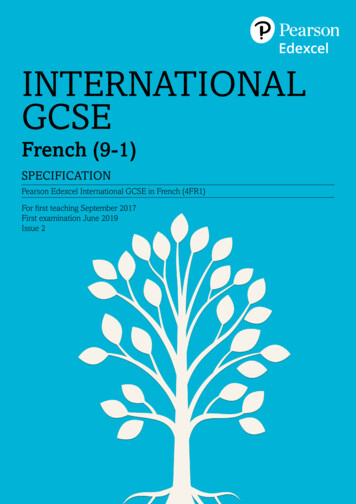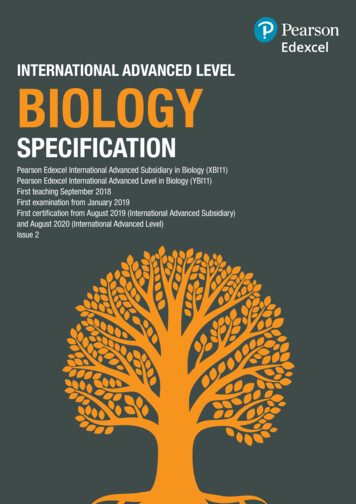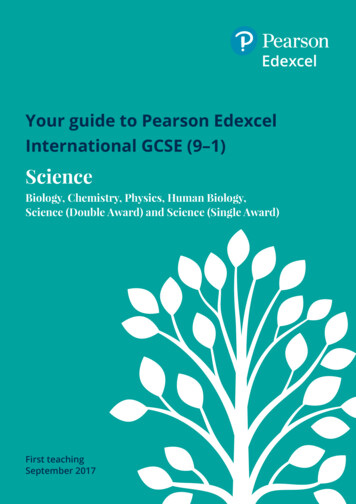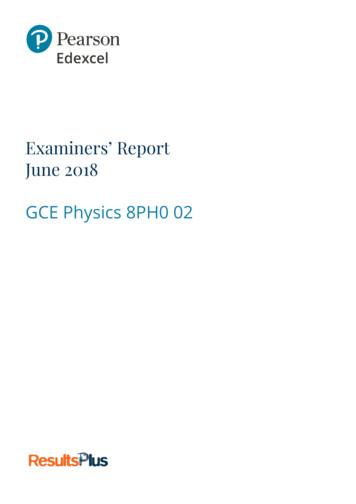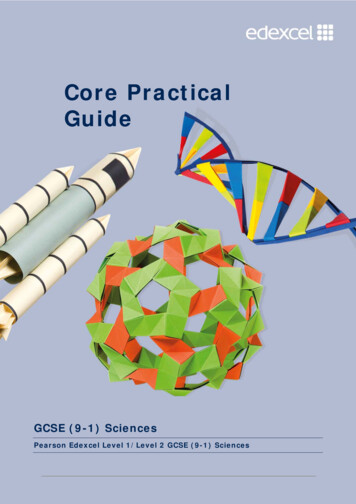
Transcription
Core PracticalGuideGCSE (9-1) SciencesPearson Edexcel Level 1/Level 2 GCSE (9-1) Sciences
ContentsIntroduction3BiologyCore practical descriptionsCore practical 1: Looking at cellsCore practical 2: pH and enzyme activityCore practical 3: Food testsCore practical 4: Osmosis in potato stripsCore practical 5: Microbial culturesCore practical 6: PhotosynthesisCore practical 7: RespirationCore practical 8: Fieldwork5713192327334248ChemistryCore practical descriptionsCore practical 1: Investigating the composition of inksCore practical 2: Investigating pHCore practical 3: Preparation of copper sulfateCore practical 4: ElectrolysisCore practical 5: Acid‐alkali titrationCore practical 6: Rates of reactionCore practical 7: Identifying ionsCore practical 8: Combustion of alcohols535562646873788490PhysicsCore practical descriptionsCore practical 1: Investigating force, mass and accelerationCore practical 2: Investigating speed, frequency and wavelength of wavesCore practical 3: Investigating refraction in glass blocksCore practical 4: Investigating thermal energyCore practical 5: Investigating electrical circuitsCore practical 6: Investigating the density of solids and liquidsCore practical 7: Investigating the properties of waterCore practical 8: Investigating the extension of a spring939598102104107112115120Appendices:Appendix 1: Department for Education: apparatus and techniques listAppendix 2: Core practical mappingAppendix 3: Equipment listAppendix 4: Mapping to lab book2124126135143 Pearson Education Ltd 2016
IntroductionPurpose of this guideThis guide is designed to support you in delivering the core practicals for Edexcel. Thefollowing pages, for each core practical, will: Give you links to the specification content and highlight key areas to further yourstudents’ understanding.Contain key questions you can ask to focus your students, and get them thinkingabout why they are carrying out a particular practical in a certain way.Give you a sample question (where possible), with commentary relating to theassessment, which can be used as practice to consolidate students’understanding.Changes to practical requirements in reformed GCSEsThere will not be any coursework in the GCSE (9–1) Science qualifications. Assessmentof practical work is now included as part of the final exam, and a minimum of 15% of thetotal marks must be allocated to questions related to practical. In our exams, we willhave questions on the core practicals in our specifications, as well as other questions onpracticals related to the core practicals or techniques that students should be familiarwith from their studies.As well as the practical requirement, there is a list of apparatus and techniques that hasbeen set out by the Department for Education (Appendix 1). Specifications must givestudents opportunities to cover the relevant apparatus and techniques, and this list hasbeen mapped to our core practicals to show you how we are covering all of therequirements. As long as you carry out all of the core practicals, you will automaticallycover the apparatus and techniques list. If you want to see how our core practicals mapto this list, it is mapped (along with maths skills) in Appendix 2.Approach to core practicalsIn order to meet the requirements set out by Ofqual, you need to ensure your centreconfirms that reasonable steps have been taken to secure that each learner hascompleted the practical activities set by us, and has made a contemporaneous record ofthe practical work and knowledge, skills and understanding derived from those practicalactivities.The purpose of this statement is to ensure that practical work remains an important partof GCSE Science. In your day-to-day teaching, this just means that you need to ensureyou cover the core practicals outlined by us and that your students are recording thework that they are doing as part of carrying out the core practicals. In practice, this couldjust be completing worksheets, taking results and doing some analysis or writing notes intheir exercise books as a follow up to carrying out the practical. If you prefer, you canuse a separate lab book for practical work, but this is not necessary. Indeed, as studentswill be required to have knowledge of these practical techniques and procedures for thefinal exam, it may be better to have this practical work sit alongside the relevanttheoretical knowledge.It is important to note that the approach to covering core practicals should be the sameapproach as you currently take to practical work in your science lessons. If youoccasionally cover particular techniques as a carousel, or split students into groups totake readings, there is no reason why you cannot still do this—as long as you have takenreasonable steps to ensure your students all acquire experience of carrying out thatparticular procedure or technique. Pearson Education Ltd 20163
Assessment of practical workAs a centre, you need to confirm that you have taken reasonable steps to ensure thateach student has completed the compulsory core practicals and that the evidence for thisis recorded. The practical record must include the knowledge, skills and understandingwhich that student has derived from those practical activities. To confirm that this hasbeen done, centres must complete and submit an authentication sheet to confirm that allstudents have completed these core practicals. This authentication sheet can be found asan appendix in the specifications.By signing this authentication sheet, you are confirming that reasonable steps have beentaken to ensure that all students have been given the opportunity to carry out the corepracticals outlined in the specifications. If students are ill or miss core practicals for anyreason beyond the school’s control, it does not require you to run catch up sessions forthose individual students.In exam papers, practical work will be assessed across the assessment objectives. Thesample questions included in this core practical guide outline how you can use thatquestion to consolidate your students’ understanding of that particular core practical. Theexam papers will assess student’s understanding of the practical work, and they will beat an advantage if they have carried out all the core practicals in the course.Maths skillsPractical activities offer a wide range of opportunities to cover particular mathematicalskills. As part of this guide, we have outlined where there are good opportunities to covermathematical techniques as part of each core practical. There is also a mapping inAppendix 2 which maps the maths skills outlined by the DfE to the relevant corepractical.Note: There is a Guide to Maths for Scientists which you can download from the Edexcelwebsite. This guide outlines the content that students will have covered in their mathslessons throughout KS3 and KS4. You can use this guide to help you understand howdifferent areas are approached in maths, and therefore support your teaching ofmathematical content in science lessons.4 Pearson Education Ltd 2016
BiologyThere are six core practicals in the biology section of GCSE Combined Science. GCSEBiology covers the same six practicals as well as an additional two, to make up eight corepracticals in total.This biology section outlines each core practical and gives a brief description of each one.The final part goes through each core practical in turn and outlines key skills as well asan extract of a sample exam question which links to the core practical.Core practical descriptionsNote: 1.13B and 5.18B are separate GCSE Biology only.Core practical1.61.10Investigate biologicalspecimens usingmicroscopesincludingmagnificationcalculations andlabelled scientificdrawings fromobservationsInvestigate the effectof pH on enzymeactivityDescriptionThis practical allows students to develop their skills inusing a light microscope, preparing slides, andproducing labelled scientific drawings. Students needto be familiar with the set-up and use of a lightmicroscope, as well as to be able to identify structuresthat they see. Magnification calculations will also berequired.For this core practical students will investigate theeffect of pH, however other variables can also beinvestigated to enhance practical work in this area.This method uses amylase (in solutions of differentpH) to break down starch. The reaction can bemonitored by using iodine to test the presence ofstarch in the solution with a continuous samplingmethod. To maintain the temperature of the solution,a Bunsen burner and water beaker must be used.Carry out food tests shown below:1.13B1.16Investigate the useof chemical reagentsto identify starch,reducing sugars,proteins and fatsInvestigate osmosisin potatoes Pearson Education Ltd 20161.identify starch by using iodine solution2.identify reducing sugars using Benedict’ssolution (and a water bath)3.identify protein using the Biuret test (addingpotassium hydroxide to a solution of the food,followed by copper sulfate)4.identify fats and oils (lipids) using the emulsiontest to show the formation of a precipitateA known mass of potato must be added to sucrosesolution, left for some time, and the final massrecorded to obtain the percentage change in mass.This investigation looks at the exchange of waterbetween the potato and solution and allows theconcentration of sucrose in the potato to bedetermined. The practical provides an opportunity forthe appreciation of the need to control variables.5
5.18BPetri dishes pre-poured with agar must be inoculatedwith bacteria and discs of antiseptic/antibiotics/plantextracts can be used to determine their effect onbacterial growth.Sterile aseptic technique must include the use of aBunsen burner.Investigate the effectof light intensity onthe rate ofphotosynthesisAlgal balls (or similar) must be set up and placed atvarying distances from a light source to investigatethe effect of light intensity on the rate ofphotosynthesis. The rate must be measured andcompared to the distance away from the light source.8.11Investigate the rateof respiration inliving organismsUse of a simple respirometer to measure the effect oftemperature on the oxygen consumption of somesmall organisms. A simple respirometer can be madeusing a tube with soda lime, cotton wool andorganisms with a capillary tube to coloured liquid.Students can then track the progress of the liquid upthe capillary tube over a set time. This experimentmust be carried out using a water bath set at differenttemperatures. Safety and ethical considerations mustalso be covered.9.5Investigate therelationship betweenorganisms and theirenvironment usingfield-worktechniques, includingquadrats and belttransects6.56Investigate theeffects of antiseptics,antibiotics or plantextracts on microbialculturesThis practical provides the opportunity for learners tocarry out aseptic techniques (Biology statement 5.17).This investigation involves the use of a belt transectalong a gradient (e.g. shaded area to an area with noshade). It involves students thinking about how tosample their chosen area, including the identificationand observation of plants/organisms. Pearson Education Ltd 2016
Core practical 1: Looking at cells1.6Core practical: Investigate biological specimens using microscopes, includingmagnification calculations and labelled scientific drawings from observationsLinks to the specification content1.3Explain how changes in microscope technology, including electronmicroscopy, have enabled us to see cell structures with more clarity anddetail than in the past and increased our understanding of the role of subcellular structures1.4Demonstrate an understanding of number, size and scale, including theuse of estimations and explain when they should be used.1.5Demonstrate an understanding of the relationship between quantitativeunits in relation to cells, including:amilli (10-3)bmicro (10-6)cnano (10-9)dpico (10-12)ecalculations with numbers written in standard formIntroducing the practicalThis core practical provides the opportunity for students to develop their skills in the useof a light microscope, the preparation of slides and the production of labelled scientificdrawings from their observations. It then provides a context for the teaching andunderstanding of the associated maths skills including magnification calculations, the useof estimations and the relationship between quantitative units. For higher tier candidates,there is the opportunity to practice calculations using standard form. A comparison ofobservations made using a light microscope with images taken using an electronmicroscope also demonstrates how improvements in microscope technology haveincreased our understanding of sub-cellular structures.Although students are likely to have used microscopes at Key Stage 3, it is a technicalskill that they find difficult. It might be worth spending time practicing the basic skillsneeded to focus the microscope before attempting the core practical, either as a starteror in a previous lesson. The core practical suggests a range of cell types which can beused and students only need to look at a plant cell and an animal cell as a minimum.Students should understand the basic principles involved in the preparation of slides foruse with a light microscope including the role of staining. Having prepared a slide, theymust understand how to use the light microscope to focus in the specimen. They need tounderstand the total magnification produced by the eyepiece and objective lens and themathematical relationship between magnification, image size and actual size. The soleuse of pre-prepared slides will be insufficient to meet the demand of the core practical,but it does provide the opportunity for students to practice using a microscope and refinetheir skills for scientific drawings.Link to GCSE Science 2011: 1.5 ‘Demonstrate an understanding of how changesin microscope technology have enabled us to see cells with more clarity anddetail than in the past, including simple magnification calculations.’ From B2Topic 1 The building blocks of cells. Pearson Education Ltd 20167
Investigating biological specimensQuestions you could ask to enhance learning and focus your students onimportant aspects of the practical: What sub-cellular structures are likely to be observed using a light microscope?Why are some sub-cellular structures not visible using a light microscope?What precautions are needed when preparing a microscope slide?Why should samples of animal cells be disposed of in disinfectant?Why does the layer of specimen cells need to be thin?Why do we stain the specimen cells?Why does the coverslip have to be carefully applied?What is the highest magnification for the light microscope?How is the focusing wheel used?When should the fine focusing wheel be used?What is a field of view and how can its size be measured?How is the actual size of a cell structure determined from microscopemeasurements?How can more detail be observed in cells?What are the important features of a drawing made from observations?Skills that are covered in the practical: The preparation of microscope slidesThe importance of staining a specimenThe ability to use a microscope to make observationsThe drawing of observations of specimens from a light microscopeMagnification calculations from observationsMaths skills: 8Calculations of total magnificationThe mathematical relationship between magnification, image size and actual sizeMake estimations of sizeUnderstanding of scale and the relationship between different quantitative units(e.g millimetres, micrometres and nanometres)Calculations using numbers in standard form for higher tier candidates only Pearson Education Ltd 2016
Sample questionThese examples are taken from the sample assessment material. It is a mix of questionsfrom 1BI0/1F and 1BI0/1H which illustrate a range of questions applicable to this corepractical and the skills associated with it. The commentary below outlines how the skillsstudents will have gained by carrying out the practical may be shown in the final exams.Part (c)(i) is a question where students have to apply their knowledge on thetechnique of using a microscope which they obtained by completing the corepractical. Pearson Education Ltd 20169
Part (c)(ii) asks students to recognise the role of staining specimens to make cellstructures more visible.Part (b)(i) is a question asking students to use their knowledge of a microscopeto calculate the total magnification obtained by the combination of the eyepieceand objective lens.10 Pearson Education Ltd 2016
Part (b)(ii) is a question that asks students to apply their knowledge on makingestimations to an image. It does not require a magnification calculation. Pearson Education Ltd 201611
Part (c) is a question that combines the maths skills of a magnification calculationwith the quantitative relationship between micrometres and millimetres.12 Pearson Education Ltd 2016
Core practical 2: pH and Enzyme activity1.10 Core practical: Investigate the effect of pH on enzyme activityLinks to the specification content1.7Explain the mechanism of enzyme action including the active site andenzyme specificity1.8Explain how enzymes can be denatured due to changes in the shape ofthe active site1.9Explain the effects of temperature, substrate concentration and pH onenzyme activity1.11Demonstrate an understanding of rate calculations for enzyme activity1.12Explain the importance of enzymes as biological catalysts in the synthesisof carbohydrates, proteins and lipids and their breakdown into sugars,amino acids and fatty acids and glycerolIntroducing the practicalThere are many factors which affect the activity of enzymes. The core practical focuseson pH, but there is also a suggested practical on the effect of substrate concentration onenzyme activity, which could be used to enhance learning. In addition, there is someinformation about a demonstration that can be used to demonstrate the calculation ofthe initial rate of enzyme action.The core practical which looks at how pH affects the breakdown of starch using amylasehas two knowledge aspects to it, enzyme activity and the breakdown of starch intosmaller sugars. It also covers the use of iodine to identify the biological molecular starch,which is a biology-only specification point. Candidates may have completed variations onthis practical during Key Stage 3, particularly linked to digestion. As part of the GCSE,candidates should focus on the practical details and use of their increased knowledge onenzyme action to interpret and explain their results. The additional practical looks at theeffect of increasing the concentration of hydrogen peroxide on the enzyme activity of theenzyme catalase.Link to GCSE Science 2011: 1.32 ‘Investigate the factors that affect enzymeactivity’ is a core practical in GCSE Biology 2011 Unit B2 Topic 1.The effect of pH (core practical)Questions you could ask to enhance learning and focus your students onimportant aspects of the practical: Why is iodine solution used?Why are syringes used to measure the volumes of the solutions?Why does the mixture need to be stirred?Why are the solutions added in the order stated? (amylase solution, pH solutionand starch solution)Why is the timer started after the starch solution is added?Why must the syringes be used in the same solutions when the investigation isrepeated?What are the main errors in this procedure?How can you improve the procedure?What other factors could have affected the results? Pearson Education Ltd 201613
How is the rate of reaction being measured?What safety precautions are used in the practical?Skills that are covered in the practical: measuring volumes accurately using syringessampling a reaction at set time intervals, timed by a stop clockability to manipulate apparatus, avoiding cross-contamination and recordingobservationsability to carry out investigation safelyMaths skills: 14mean calculationsgraph drawing Pearson Education Ltd 2016
Sample questionThis example is taken from the sample assessment material, paper 1BI0/1BH, Q8. Thecommentary below outlines how the skills students will have gained by carrying out thepractical may be shown in the final exams. Pearson Education Ltd 201615
Part (a)(i) is a question where students are asked to apply their knowledge ofthis core practical to an unfamiliar situation, where it looks at a practical they arenot familiar with. They should be able to use their understanding of the corepractical they have carried out combined with their theoretical knowledge and theinformation given in the question to give an answer.Part (a)(ii) requires students to interpret the data that they have been presentedwith to describe the effect of temperature on lipase activity. They should befamiliar with the general effect of temperature on the activity of enzymes, andthis knowledge can be used to interpret the graph.16 Pearson Education Ltd 2016
This part extends the candidates’ knowledge to explain the effect of hightemperature on the activity of lipase. This is an application mark as it appliestheir knowledge of the mechanisms of enzymes to practical results that arepresented in the question. Pearson Education Ltd 201617
This part asks candidates to calculate the rate of enzyme activity by firstcalculating the mean, and then working out the rate. Candidates have to obtainthe correct data from the table and use it to calculate the rate. It focuses on themaths skills required.18 Pearson Education Ltd 2016
Core practical 3: Food tests1.13B Core practical: Investigate the use of chemical reagents to identify starch,reducing sugars, proteins and fatsLinks to the specification content1.12Explain the importance of enzymes as biological catalysts in the synthesisof carbohydrates, proteins and lipids and their breakdown into sugars,amino acids and fatty acids and glycerol1.14B Explain how the energy contained in food can be measured usingcalorimetryIntroducing the practicalThis core practical is only required for biology and not combined science. It coverstechniques and skills that students are likely to have encountered during Key Stage 3.Consequently, the resource to support this core practical suggests that students plan theinvestigation to test a range of foods for starch, reducing sugars, proteins and fats. Thisprovides students with the opportunity to develop their skills in writing methods,determining what equipment is required and considering safety hazards and how theywould deal with these. It may be necessary to split this practical into two lessons, one toplan and one to complete the investigation.Students will be required to remember the reagents needed to test for starch, reducingsugars, protein and lipids, the methods used for the food tests as well as both positiveand negative observed results. They will then be able to link this information to the roleof enzymes in the synthesis of carbohydrates, proteins and lipids and their breakdowninto sugars, amino acids and fatty acids and glycerol. This core practical is in topic 1 andas such could be linked to relevant theoretical knowledge across both paper 1 and paper2.Link to GCSE Science 2011: 3.14 ‘Explain the role of digestive enzymes,including:a carbohydrases, including amylase, which digest starch to simple sugarsb proteases, including pepsin, which digest proteins to amino acidsc lipase, which digests fats to fatty acids and glycerol’in GCSE Biology 2011 Unit B2 Topic 3.Questions you could ask to enhance learning and focus your students onimportant aspects of the practical: Why should all the food tests be done on each food sample?What effect could cross contamination have on the observed results?How can cross contamination of samples be avoided?What safety hazards will be encountered during the practical work?How can safety hazards be minimised or prevented?What is the best way to present results that are qualitative?How could qualitative food tests be modified to produce semi-quantitative orquantitative data?Why might the result for reducing sugars be negative in a food whose food labelshows it contains sugar?What are the roles of each food group in the body? Pearson Education Ltd 201619
How do the results for each food test link to its potential role as part of a balanceddiet?Skills that are covered in the practical: Determining equipment needed for a practicalWriting a methodRecognising safety hazards and controlling risksCareful labelling and manipulation of apparatus to avoid cross contaminationRecording of quantitative data in a results tableUse of scientific ideas to interpret resultsSample questionThese examples are taken from the sample assessment material. The question is from1BI0/1F. The first part of the question requires knowledge gained from the core practical.The second part of the question shows how skills gained from completing core practicalscould be applied to new contexts in exam questions. The question links to sugar, the testfor which is described in the first part of the question. The commentary below outlineshow the skills students will have gained by carrying out the practical may be shown inthe final exams.This question requires recall of the reagent used to test for the presence ofglucose and the colour change observed with a positive result.20 Pearson Education Ltd 2016
This question requires the interpretation of a set of results from an investigationthat will be unfamiliar to students. The information in the stem of the question isneeded to interpret the results given in the table. This would also requirestudents to have an understanding of the maths concept of percentage change inmass. Pearson Education Ltd 201621
This question requires students to justify a conclusion by comparing two pieces ofdata and combine it with information given in the stem of the question as part ofthe justification.This question requires students to recognise the limitations of an unfamiliarinvestigation and suggest possible improvements. Students should work ondeveloping this skill when completing practicals during the course.22 Pearson Education Ltd 2016
Core practical 4: Osmosis in potato strips1.16 Core practical: Investigate osmosis in potatoesLinks to the specification content1.15Explain how substances are transported into and out of cells, including bydiffusion, osmosis and active transport1.17Calculate percentage gain and loss of mass in osmosisIntroducing the practicalThis core practical uses potato strips to demonstrate osmosis. The potato strip will loseor gain mass, due to osmosis, depending on the concentration of solutes in the solution.The practical can be completed within an hour lesson and combining class data allows theopportunity for enhanced analysis of the results. The practical pre-prepares the sucrosesolutions and potato strips but it would be helpful to discuss how this was done to controlrelevant variables. The practical addresses a few areas which candidates find difficultincluding the idea that a solution with a high concentration of solute molecules containsfewer water molecules and the calculation of percentage change in mass. Graphicalanalysis of the results gives the opportunity for candidates to determine the isotonicconcentration of the potato.Link to GCSE Science 2011: 2.21 ‘Investigate osmosis’ is a core practical in GCSEBiology 2011 Unit B2 Topic 2.Osmosis in potato stripsQuestions you could ask to enhance learning and focus your students onimportant aspects of the practical What variables can arise with the potato strips?Why do the potato strips have to be blotted dry?Why are the potato strips the same width and length?What precautions must be taken to ensure the mass of the potato is accuratelyrecorded?How have the sucrose solutions been prepared?Which sucrose solution has the highest number of water/solute molecules?Why should the potato strips be left in the solutions for at least 15 minutes?What are the main errors in this procedure?How can you improve the procedure?What safety precautions are used in the practical?What is the benefit of combining the class data before the analysis is completed?Skills that are covered in the practical: Using a balance accuratelyAccurate labelling to identify samples in an investigationRecording observations (e.g. mass of potato strips)Ability to carry out investigation safelyMaths skills: Calculating percentage change in massIdentifying anomalous resultsCalculating mean valuesPlotting a scatter graphDetermining the graph intercept point to identify the isotonic value Pearson Education Ltd 201623
Sample questionThis example is taken from the sample assessment material, paper 1BI0/1BH, Q5(a).The commentary below outlines how the skills students will have gained by carrying outthe practical may be shown in the final exams.24 Pearson Education Ltd 2016
This question requires candidates to understand the controlled variables in thecore practical. The direct link to the core practical makes this a knowledge-basedquestion.This is an analysis question as it requires candidates to draw a conclusion aboutthe specific data point on the graph. They will need to explain that the valuerepresents the point where there is zero percentage change in mass. Pearson Education Ltd 201625
This is also an analysis question requiring candidates to suggest how theinvestigation could be extended to collect more data to accurately determine thepoint where there is zero percentage change in mass.26 Pearson Education Ltd 2016
Core practical 5: Microbial cultures5.18B Core practical: Investigate the effects of antiseptics, antibiotics or plant extractson microbial culturesLinks to the specification content5.10B Describe how plants defend themselves against attack from pests andpathogens by producing chemicals, some of which
use a separate lab book for practical work, but this is not necessary. Indeed, as students will be required to have knowledge of these practical techniques and procedures for the final exam, it may be better to have this practical work sit alongside the relevant theoretical knowledge.
